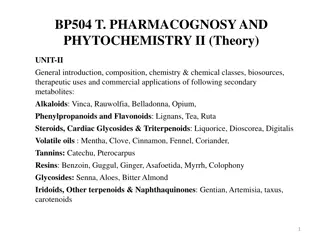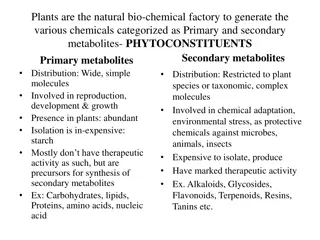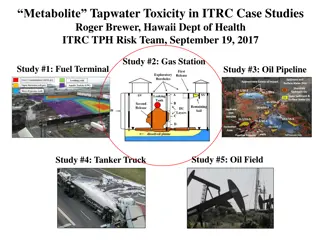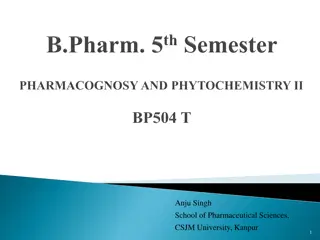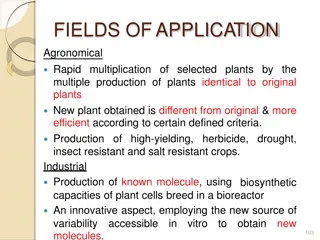Understanding Bioreactors: Components and Functions
Bioreactors are essential vessels used for the production of various chemicals and biological reactions. They provide controlled conditions for fermentation processes, including agitation, aeration, temperature, and pH control. Key components such as fermenter vessels, heating, cooling apparatus, an
10 views • 16 slides
Understanding Plant Metabolites: Primary vs. Secondary & Their Biological Functions
Primary metabolites are crucial for plant survival, including sugars and amino acids, while secondary metabolites, like tannins, terpenoids, and flavonoids, play diverse roles such as protection from pathogens, pigmentation, and health benefits. Tannins offer antiviral and antibacterial effects, ter
1 views • 7 slides
Understanding Glycosides: Secondary Metabolites in Pharmacognosy
Glycosides are naturally occurring compounds with sugar and non-sugar components. They are characterized by glycosidic bonds and can be chemically separated. These compounds exhibit various physical and chemical properties, including solubility, taste, and optical activity. Classification based on g
1 views • 11 slides
Techniques for Investigating Plant Metabolic Pathways and Biogenetic Studies
This content explores various techniques used in pharmacognosy and phytochemistry to investigate the metabolic pathways in plants and study the formation of primary and secondary metabolites. Methods such as utilizing radioactive isotopes, tracer techniques, isolated organs/tissues, grafting, and mu
4 views • 12 slides
Understanding Anthracene Glycosides in Pharmacognosy and Phytochemistry
Anthracene glycosides are secondary metabolites found in various plant families, offering therapeutic benefits. This comprehensive study explores their composition, chemistry, biosources, and applications, detailing the structural variations of aglycones and sugars present in these compounds. Method
0 views • 30 slides
Understanding Secondary Metabolites of Rue (Ruta graveolens)
Rue (Ruta graveolens) is a herb known for its medicinal properties and aromatic leaves. It contains various chemical constituents such as flavonoids, alkaloids, fixed oils, and volatile oils. The herb has a long history of traditional uses, including as an insect repellent and a condiment. Chemical
0 views • 10 slides
Pharmacognosy and Phytochemistry II: Secondary Metabolites and Their Therapeutic Applications
This unit delves into the composition, chemistry, therapeutic uses, and commercial applications of secondary metabolites such as steroids, cardiac glycosides, and triterpenoids. It explores the properties of saponin glycosides, their classification based on aglycone nature, and the significance of s
0 views • 23 slides
Understanding Plants: Primary Vs. Secondary Metabolites and Alkaloids
Plants act as natural bio-chemical factories producing primary and secondary metabolites with distinct roles in growth and adaptation. Primary metabolites are essential molecules like carbohydrates and proteins, while secondary metabolites like alkaloids have marked therapeutic activities. Alkaloids
0 views • 7 slides
Understanding Metabolic Control Mechanisms in Cellular Regulation
Metabolic control mechanisms play a crucial role in maintaining homeostasis within cells by regulating metabolic pathways. This involves finely adjusting the output of pathways in response to external signals, ensuring the proper flux of metabolites to meet cellular needs. Pacemaker enzymes, such as
1 views • 17 slides
Understanding Resins: Composition, Occurrence, and Classification
Resins are solid/semisolid amorphous products with complex chemical composition and are found in plants, animals, and fossils. They contain essential oils, terpene products, and carboxylic acids. Resins occur as a result of normal metabolism or in response to injury, forming physiological or patholo
1 views • 37 slides
Understanding Biosynthetic Pathways in Living Organisms
Biosynthesis, also known as anabolism, involves the formation of complex organic compounds from simple subunits catalyzed by enzymes within living organisms. This process is vital for the development of life and the production of essential compounds like carbohydrates, proteins, vitamins, antibiotic
1 views • 21 slides
NMR Applications in Organic Chemistry Research
NMR (Nuclear Magnetic Resonance) is a powerful technique used in organic chemistry research for a wide range of applications, including structure elucidation, identification of small molecules, quantitative analysis, and studying dynamics. Through various NMR experiments, researchers can determine s
1 views • 13 slides
Overview of Secondary Metabolites: Alkaloids, Flavonoids, Steroids, and Glycosides
Exploring the diverse world of secondary metabolites, this content delves into the composition, chemistry, biosources, therapeutic uses, and commercial applications of various compounds such as Alkaloids, Flavonoids, Steroids, Glycosides, and more. It discusses the structural characteristics, biolog
0 views • 17 slides
Understanding Translocation in the Phloem
This lecture explores the process of translocation in the phloem, supported by evidence from studies such as aphid experiments, ringing experiments, and the use of radioactive isotopes. It delves into the materials translocated in phloem sap, including water, sucrose, non-reducing sugars, nitrogen c
5 views • 18 slides
Exploring Radio Tracer Techniques in Pharmacognosy and Phytochemistry II
In this unit, the focus is on metabolic pathways in higher plants and leveraging radioactive isotopes for biogenetic studies. Topics covered include steps in tracer techniques, selection of radioisotopes, preparation of labeled compounds, and insertion of radio-labeled metabolites in plant parts usi
0 views • 9 slides
Methods of Detection in Tracer Technique for Biogenetic Studies
Explore the methods utilized in tracer techniques for investigating biogenetic pathways in plants. Learn about competitive feeding, precursor-product sequence method, sequential analysis, and isotope incorporation. These methods involve labeling experiments to trace metabolic pathways and understand
0 views • 17 slides
Overview of Indole Alkaloids in Pharmacognosy and Phytochemistry II
Indole alkaloids are a significant group of naturally occurring compounds with diverse chemical structures and physiological actions. This unit delves into the general introduction, composition, chemistry, biosources, therapeutic uses, and commercial applications of various secondary metabolites, in
0 views • 17 slides
Overview of Secondary Metabolites: Alkaloids, Glycosides, Flavonoids, and More
Secondary metabolites are chemical compounds produced by plants that have various biological effects. Alkaloids, a type of secondary metabolite, are organic compounds with nitrogen atoms and specific physiological actions. They exhibit diverse physical and chemical properties, making them essential
0 views • 63 slides
Understanding Fatty Acid Metabolites Pathways and Functions
This article explores the complex biochemical pathways involved in the metabolism of fatty acids and their conversion into various metabolites. Fatty acid metabolites play essential roles in cellular energy production, signaling, and structural funct
0 views • 9 slides
Understanding Petroleum Metabolite Toxicity in Environmental Case Studies
Exploring the impact of metabolites from petroleum degradation on tap water toxicity through case studies involving gas stations, fuel terminals, oil pipelines, oil fields, and tanker trucks. The assessment of TPH risk levels in different settings, calculation of screening levels for drinking water,
0 views • 17 slides
Exploring the World of Fungal Biotechnology
Fungal biotechnology involves utilizing living organisms like fungi for industrial applications, leading to the production of various valuable products such as enzymes, vitamins, and secondary metabolites. This field not only benefits industries by offering energy-efficient processes but also contri
0 views • 15 slides
Plant Tissue Culture: Historical Development, Techniques, and Applications
Plant tissue culture is an experimental technique that involves the in-vitro cultivation of plant cells to produce secondary metabolites, regenerate plants, and study organogenesis. This process allows for the maintenance of disease-free plant material, biosynthetic pathway tracing, and cell immobil
0 views • 21 slides
Exploring Secondary Metabolites in Ruta Graveolens for Therapeutic Applications
Delve into the world of secondary metabolites found in Ruta graveolens, commonly known as Rue or Garden Rue. Discover its rich composition of alkaloids, phenylpropanoids, flavonoids, steroids, cardiac glycosides, triterpenoids, volatile oils, tannins, resins, glycosides, iridoids, and other terpenoi
0 views • 13 slides
Understanding Plant Tissue Culture: A Brief Introduction
Plant tissue culture involves the in-vitro cultivation of plant cells or tissues under controlled conditions for various applications like the production of metabolites and plant regeneration. This experimental technique facilitates the production of callus from explant tissues, which can be used fo
0 views • 39 slides
Plant Tissue Culture Applications in Agriculture and Biotechnology
Plant tissue culture technology is a versatile tool used in agronomy and biotechnology for rapid multiplication of selected plants, production of high-yielding, herbicide, drought, insect, and salt-resistant crops, as well as the generation of phytopharmaceuticals, secondary metabolites, and novel c
0 views • 17 slides
Enhancing Bioactive Sulforaphane Formation in Cooked Brassica Vegetables
Brassica vegetables contain glucosinolates, which are secondary plant metabolites with potential health benefits. Dr. Sameer Khalil Ghawi's research explores a novel approach to intensify the formation of the bioactive sulforaphane in cooked Brassica vegetables by optimizing the glucosinolate-myrosi
0 views • 25 slides
Applications and Industrial Production of Fermentation in Various Sectors
Fermentation plays a crucial role in the production of organic solvents, food products, condiments, dairy products, processed meats, beverages, vitamins, and pharmaceutical compounds like antibiotics and vaccines. Specific examples include the production of citric acid, lactic acid, monosodium gluta
0 views • 6 slides
Understanding the Pentose Phosphate Pathway in Metabolism
The Pentose Phosphate Pathway, also known as the Hexose Monophosphate shunt, is an alternative route for glucose metabolism that plays a crucial role in NADPH synthesis, fatty acid production, antioxidant activity, and nucleotide formation. This pathway involves oxidative and non-oxidative phases, r
0 views • 12 slides
Understanding the Impact of Aflatoxin Contamination in Africa
Aflatoxins, fungal metabolites produced by Aspergillus flavus, pose a significant challenge in Africa, affecting various crops and leading to health risks, including liver cancer and immune suppression. The contamination impacts trade, agriculture, and food security, with regulations affecting regio
0 views • 31 slides
Exploration of Tropane Alkaloids: Atropine, Scopolamine, and More
Tropane alkaloids are a diverse group of secondary metabolites found in plants like Atropa belladona and Datura stramonium. Known for their medicinal properties, these alkaloids have notable therapeutic uses and can be chemically classified based on their structures and biosources. Atropine and scop
0 views • 10 slides
Understanding Body Weight Gain in Clozapine-Treated Patients: Norclozapine's Role
Dive into the investigation by Naomi Jessurun, PharmD, exploring whether norclozapine is responsible for body weight gain in patients treated with clozapine. The research delves into the impact of drug metabolization and metabolites on adverse reactions, shedding light on the complexities surroundin
0 views • 43 slides
Understanding Alkylating Agents in Oncology: Mechanisms and Pharmacokinetics
Alkylating agents have a long history as anti-cancer drugs, with Mechlorethamine being the first developed in 1942. They react with cells in all phases of the cell cycle, causing DNA alkylation and cross-link formation. Common alkylating agents include Cyclophosphamide, Melphalan, and Temozolomide.
0 views • 75 slides
Advancing Multi-Omics Research with Integrated Methods
Exploring the importance of multi-variate methods in multi-omics research to integrate diverse datasets such as phenotypes, metabolites, expression, methylation, and SNPs. The overview covers matrix-based methods, sparse methods for feature selection, and an example analysis from the MESA Multi-Omic
0 views • 17 slides
Understanding Genetic Interaction and Epistasis in Biosynthetic Pathways
Genetic interaction and epistasis play crucial roles in determining phenotypic traits through the intricate network of genes, enzymes, and metabolic pathways. This concept is illustrated through a detailed explanation of how mutations in specific genes can affect the production of metabolites and ul
0 views • 24 slides
Dr. Seyyed Aliakbar Hedayati - Marine Biology and Fisheries Expert
Dr. Seyyed Aliakbar Hedayati holds a Ph.D. in Marine Biology and is currently an Assistant Professor of Marine Biology at Gorgan University. His research interests include marine biology and fisheries. He has published various research papers on topics such as plasma metabolites in fish and length-w
0 views • 15 slides
Understanding Plant Chemistry and Phytonutrients: Insights from Research
Exploring the diverse world of plant chemistry, this content delves into primary and secondary metabolites, highlighting the significance of phytonutrients in maximizing nutritional content. Various hypotheses such as the Insecticide Hypothesis and Co-evolution Hypothesis are discussed, shedding lig
0 views • 61 slides
Fourier-transform Infrared Spectroscopy Analysis of Jatropha curcas Latex Silver Nanoparticles
Utilizing Fourier-transform infrared spectroscopy, this paper discusses the analysis of hexane/methanol extracts of Jatropha curcas latex silver nanoparticles. The study explores the biosynthesis of nanoparticles using plant secondary metabolites as reducing agents, highlighting the medicinal proper
0 views • 15 slides





